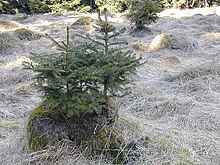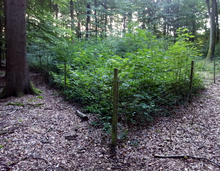Natural rejuvenation

In forestry, natural regeneration is defined as a result of flown or opened seeds, seeds by surrounding trees or vegetative propagation , for example stick rash , emerging forest stand or part of it. In contrast to this, the forest culture is an artificially created offspring by sowing or planting.
Designations
- Surcharge : the natural regeneration that has arisen from non-airworthy seeds. These include, for example, the seeds of oak, red beech and horse chestnut. The fruits fall straight to the ground (hit). This form of spread is called barochory in biology.
- Approach : the natural regeneration that emerged from airborne seeds. Many tree species have particularly light seeds. The spread through the air, especially when there is wind, is often additionally supported by the special shape of the seeds. These include spruce , pine , maple , ash , poplar and willow . This form of spreading is called anemochory in biology.
To a lesser extent, tree seeds are also spread by birds ( jays ) or mammals ( squirrels ), who build up and forget about food supplies.
The advantages of natural regeneration are above all cost savings (no purchase of plants, no planting work) and often optimal adaptation to the existing location : If the generation preceding natural regeneration has already grown successfully at the same location, this can also be expected of the offspring.
The disadvantage is the connection to already existing tree species and their genetic potential.
Main problem for the growth of natural regeneration in Germany are often inflated deer - Dam - and deer population in respect of which protective measures such. B. the expensive installation of a game fence are necessary. Weiser gates are set up to demonstrate the natural regeneration potential of an area.
literature
- Ernst Röhrig , Norbert Bartsch , Burghard von Lüpke , Alfred Dengler (founder): Silviculture on an ecological basis . 7th, fully updated edition. Ulmer, Stuttgart (Hohenheim) 2006, 479 pages, ISBN 3-8252-8310-0 (UTB) or ISBN 3-8001-4595-2 (Ulmer)
- Hans Leibundgut : The natural forest regeneration . 2nd, revised and expanded edition. Haupt, Bern and Stuttgart 1984, 115 pages, ISBN 3-258-03415-X
- Peter Burschel , Jürgen Huss and Reinhard Kalbhenn: The natural rejuvenation of the beech . Series of publications by the Forestry Faculty of the University of Göttingen and communications from the Lower Saxony Forest Research Institute (Volume 34). Sauerländer, Frankfurt am Main 1964, 186 pp.
- Hans Hausrath : History of German silviculture. From its beginnings to 1850 . Series of publications by the Institute for Forest Policy and Regional Planning at the University of Freiburg. Hochschulverlag, Freiburg im Breisgau 1982, ISBN 3-8107-6803-0
- Jürgen Huss : Natural Stand Regeneration . In: Jeffery Burley, Julian Evans, John A. Youngquist (Eds.): Encyclopedia of Forest Sciences . 1st edition. Elsevier, Oxford 2004, ISBN 978-0-08-054801-2 ( archive.org [PDF]).

